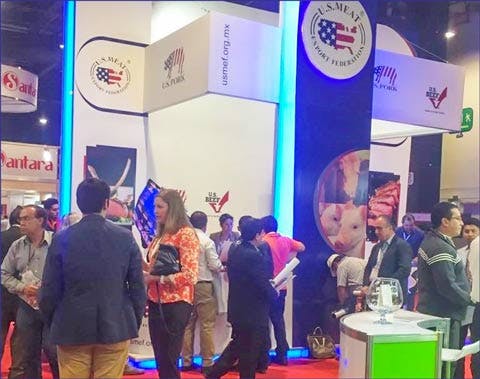U.S. Red Meat Showcased, North American Trade Highlighted at International Meat Congress in Mexico City
USMEF capitalized on a key opportunity to showcase U.S. beef and pork items and interact with meat industry leaders and government officials in Mexico City by participating in the International Meat Congress hosted by the Mexican Cattle Feeders Association (AMEG), the Mexican Agriculture, Livestock Productions and Fisheries Secretariat (SAGARPA) and Mexico’s Bovine Productive Chain Program. With support from the Beef Checkoff Program and the Pork Checkoff, USMEF sponsored a booth at the event in which U.S. beef and pork were promoted, with experts on hand to answer questions and discuss the attributes of U.S. red meat.

USMEF Economist Erin Borror addresses the International Meat Congress in Mexico City
USMEF Economist Erin Borror addressed attendees about current trends in global meat production, consumption and trade, focusing particularly on how North American meat and livestock trade has expanded and evolved since the passage of NAFTA.
Borror noted that the recent uptick in production has improved the price competitiveness of U.S. beef, both in key Asian markets and in the Western Hemisphere. This period of higher production is happening at a time of tight global beef supplies – especially from Australia, where herd rebuilding continues to hold down slaughter and production volume. For North American beef trade, key factors in 2017 include:
- U.S. production is forecast to be the largest since 2008, but U.S. demand for imported beef from Mexico and Canada remains strong, partly due to limited supplies and higher prices for imports from Australia and New Zealand.
- Mexico continues to see modest growth in its cattle inventory and beef production, but this is tempered by an uptick in feeder cattle exports to the United States so far this year. Mexico’s beef exports are at record levels, mainly to the United States. Mexico’s beef imports continue rebound, but per capita consumption remains low.
- Canada’s cattle inventory is relatively flat, with smaller live exports. Beef production and exports are increasing, but at a modest pace.
- The U.S., Mexico and Canada are unique as they are each leading exporters and importers of beef, partly due to NAFTA, which has helped bolster the competitiveness of the North American beef industries.

Educational materials on the attributes of U.S. red meat were available at the USMEF booth
Borror highlighted the fact that Mexico is a critical trading partner for the U.S. beef and pork industries, with exports to Mexico accounting for 8 percent of total U.S. pork production and 3 percent of U.S. beef production. U.S. pork exports reached 12.5 pounds per Mexican consumer last year, with beef exports totaling nearly 4.5 pounds. Total U.S. pork and beef exports to Mexico reached nearly 973,000 metric tons (mt) in 2016 and will soon exceed 1 million mt. Export value was $2.3 Billion – an increase of 43 percent in value over the past 10 years.
USMEF also sponsored a presentation by Dr. Victor Toledo titled, “Functional Meat Product Development,” which highlighted the U.S. industry’s effort to develop and introduce new beef and pork products that meet the culinary and nutritional needs of Mexican consumers. Dr. Toledo’s research looks at the development of cured and cooked meat products with a specific focus on certain added characteristics such as antioxidant capacity. He also discussed research conducted on the use of plant-origin omega-3 fatty acids to determine their residual benefits in processed meat products.
